Easing Fear and Dread
Fear and dread are related to our neuroception. It is true that we have experienced bad things happening that are due to external factors. We can’t un-know this.
It doesn’t help to try to talk ourselves out of feelings of dread and anxiety because fear happens in our unconscious, not our verbal conscious level of mind. When someone else does this, it feels minimizing and condescending.
Don’t be silly. You’re exaggerating. It won’t happen to you.
We protest. You don’t know that. Bad things happen all the time!
Our predictive brain, with its negativity bias, tries to apply what it knows to other situations. If this bad thing could happen in this situation then ...
This strategy to try to protect ourselves feeds catastrophic thinking which is harmful because it alarms our nervous system and creates more hypervigilance. A certain level of planning and preparedness is helpful, but entertaining worst-case scenario thinking drains of us strength and resilience, leaving us afraid and anxious. It doesn’t work to protect us.
Our brain developed to visually take in and respond to immediate threat
Watching video footage of traumatic events (like we do on the news and social media) alarms the brain and increases hypervigilance. Our brain doesn't know this traumatic event is happening far away and is not an immediate danger to us personally.
“Bad things” can be personal, like an accident or illness, or global/societal like Covid and climate change. Let’s work with personal experience, which often begins in childhood.
Many children have persistence experiences of fear. They live without the assurance of knowing their body will be safe. Addiction, violence and mental illness in the home contribute. Systemic injustice like racism and poverty raise stress levels and can make for a volatile situation.
Children without housing and food security are actually in more danger. They can’t sleep because they can’t reliably predict safety. They don’t perform well in school because they’re exhausted. They have trouble trusting people because of their experience, or they become desperate to connect and trust and don’t clearly assess safety and danger. These children are often the bullied or bullies.
If this was your experience, you know this in your bones. If not, imagine for a moment waking up throughout your childhood feeling anxiety and dread. Before you even get out of bed, your brain, using actual evidence from the past, is predicting that bad things are going to happen to you today. You don’t know how or when, but your experience tells you that it likely will. If it doesn’t happen today, you still need to keep alert because it will soon.
Your nervous system has been conditioned into hypervigilance through years of uncertainty and harm. Click here for more on Adverse Childhood Experiences.
For some of us, the danger happened socially more than at home. We were assaulted, shamed and objectified. Systemic gender and racial inequality are an every day experience that cost us dearly in energy and in the way our brain forms neural networks for protection rather than connection.
Our survival system of neuroception and survival responses of fight/ flight/ freeze/ fawn developed over millennia within in a certain context. Modern life and globalization have created a different world and daily life. We need to work at bringing our nervous system up to date to cultivate strength and resilience to meet our life as it is now.
It doesn’t help to minimize our situations or pretend danger doesn’t exist. We can’t talk ourselves out of it. What does work?
Regulating into the safety of the present moment helps to lower the level of alarm. Using breathing, tapping, frame/trace and other grounding and orienting tools can help us experience more accurate neuroception which reduces the level of alarm and hypervigilance.
We come out of survival responses and band together with others to take appropriate action.
Join us in our Sunday free community class to inquire and share with like minded people.
Enhance your nervous system regulation through regular relaxation and breathing practices.
We don’t have to remain in survival mode at the mercy of hypervigilance
It takes time to heal long standing experiences and evidence in our nervous system. We can lower social anxiety and our general fear level.
We will always know what can happen. We can also sharpen our neuroception so we are clear about what is a threat, what is not, and at what level.
We are not powerless
Especially when we are regulated and in connection, we will be able to relax and predict with more accuracy. We have adult agency and resources now. We can bring this strength into our daily experience and build resilience to manage life as it is.
Join us at 10AM Eastern to explore easing fear and dread in our Sunday free community class.
Join me at 11:30AM Eastern for a half hour guided somatic inquiry on Insight Timer Live
My Nervous System Protects Me: Guided inquiry on Insight Timer

